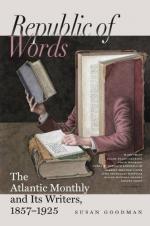Between low-water and the Cliff are hundreds of pools rich in vegetable and animal life—Look at this one: it is a lakelet of exquisite beauty. Bordered with the olive-colored Rock-Weed, fronds of purple and green Laver rise from its limpid depths. Amphipods of varied hue emerge from the clustering weeds, cleave the clear water with easy swiftness, and hide beneath the opposite bank. Here a graceful Annelid describes Hogarth’s line of beauty upon the sandy bottom. There another glides over the surface with sinuous course, rowed by more oars than a Venetian galley, more brilliant in its iridescence than the barge of Cleopatra, albeit
“The poop was beaten
gold,
Purple the sails.”
We loiter here, forgetful that we are only at the first end of the bow along whose curve we propose to walk. Let us go on. The firm sand affords pleasanter footing than the slippery stones we leave behind us, but it seems bare of promise to the curiosity-hunter. Nevertheless we will hunt, and quite at variance with my experience will it be, if we return empty-handed.
Here is something already. Dark-colored, horny, flat, oblong, each corner furnished with a wiry, thorn-like projection;—what is it? A child tells you it is a Mermaid’s Purse, and, giving the empty bag a shake, you straightway conclude that the maids of the sea know “hard times,” as well as those of the land. But the Purse is not always so light. Sometimes it is found to contain a most precious deposit, the egg which is to produce a future fish.
These egg-cases belong to different members of the Ray family. I saw one last winter, in which the inmate was fully developed. Should some old seaman hear me, he might say that I am telling a “fish-story” in good earnest. He might inform you furthermore, that the object in question is “but a pod of sea-weed, and that he has seen hundreds of them in the Gulf Stream.” I cannot help it, neither do I question his veracity. Notwithstanding, these two eyes of mine, in sound condition, awake, and in broad day, did see the supposed pericarp, with one side taken off, and did behold, lying within, as veritable a Raia as ever was caught upon the New-England coast. Moreover, its countenance was no more classical, in its minuteness, than that of its most ancient ancestor in its hugeness.
Observe those bubbles trembling upon the edge of the wave. One is left by the receding tide, and a nearer view shows it to be a jelly-like globe, clearer than the crystal of Merlin. Dropped softly into a vessel of water, at first it lies quiescent and almost invisible upon the bottom. A moment after, it rises in quick undulations, flashing prismatic tints with every motion. Again it rests, and we see that it is banded by eight meridians, composed of square, overlapping plates. It swims, and the plates become paddles, propelling the frail craft,— prisms, dividing the sunbeams into rainbow hues. Suddenly two lines of gossamer are dropped from unseen openings in its sides, and trailed behind it as it goes. Twisting, lengthening, shortening, they are drawn back and re-coiled within, and




